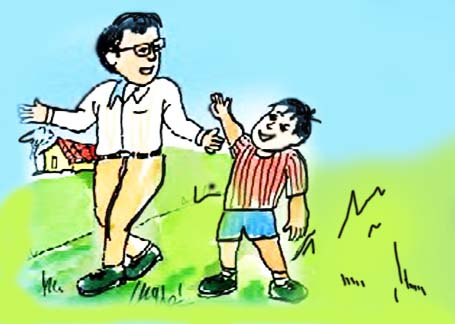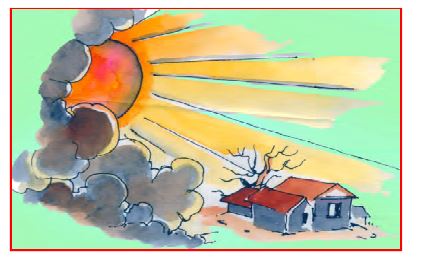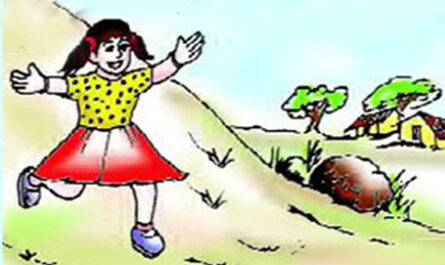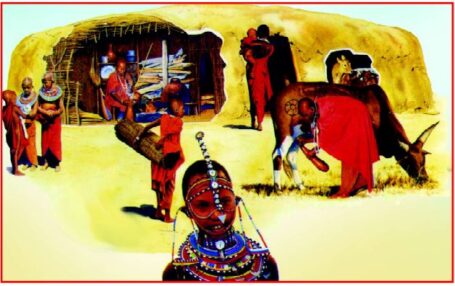जब मैं टहल रहा था तो मेरी मुलाकात एक आदमी से हुई;
हम बात करने लगे,
आदमी और मैं
तुम कहाँ जा रहे हो, यार? मैंने कहा था।
(जब वह आदमी वहां से गुजरा तो मैंने उससे कहा)
“कुछ रोटी पाने के लिए, गाँव तक जाओ
क्या आप मेरे साथ आना चाहते है? “नहीं, मैं नहीं?”
जब मैं चल रहा था तो मेरी मुलाकात एक घोड़े से हुई;
हम बात करने लगे,
घोड़ा और मैं
तुम कहाँ जा रहे हो, घोड़े, आज?
(घोड़े के जाते समय मैंने उससे कहा)
“कुछ घास लाने के लिए गाँव तक जाओ।
क्या आप मेरे साथ आना चाहते है?नहीं, मैं नहीं।
जब मैं टहल रहा था तो मेरी मुलाकात एक महिला से हुई;
हम बात करने लगे,
औरत और मैं
 इतनी जल्दी तुम वुमन के पास कहाँ जा रहे हो?
इतनी जल्दी तुम वुमन के पास कहाँ जा रहे हो?
(जब वह महिला वहां से गुजर रही थी तो मैंने उससे कहा)
“कुछ जौ लाने के लिए गाँव तक जाओ।
क्या आप मेरे साथ आना चाहते है? नहीं, मैं नहीं।
जब मैं टहल रहा था तो मेरी मुलाकात कुछ खरगोशों से हुई;
हम बात करने लगे,
खरगोश और मैं.
आप अपने भूरे फर कोट में कहाँ जा रहे हैं?
(जब खरगोश वहां से गुजर रहे थे तो मैंने उनसे कहा)
“कुछ जई लाने के लिए गाँव जाओ।
क्या आप हमारे साथ आएंगे? नहीं, मैं नहीं
जब मैं टहल रहा था तो मेरी मुलाकात एक पिल्ले से हुई;
हम बात करने लगे,
पिल्ला और मैं
आप इस अच्छे दिन कहाँ जा रहे हैं?
(जब पिल्ला वहां से गुजर रहा था तो मैंने उससे कहा)
पहाड़ियों में लोटने और खेलने के लिए ऊपर।
मैं तुम्हारे साथ आऊंगा पिल्ला, मैंने कहा।
Reading Comprehension
Answer the following questions:
1. Who does ‘I’ stand for in the title?
Ans. 1. In the title, ‘I’ stands for the narrator or the child who is speaking.
2. Why does the child talk to everyone he meets on his way?
Ans. The child talks to everyone he meets on his way probably out of curiosity or friendliness, wanting to engage in conversation and learn about where they are going and what they are doing
3. Why does the child agree to go with the puppy?
Ans. The child agrees to go with the puppy because they seem to share a common interest in rolling and playing, and the child finds the idea appealing.
4. Why does the child always say “No, not I”?
Ans. The child always says “No, not I” because they decline the invitations to accompany others, preferring to continue on their own path.
5. List the names of all those who said, “Will you come with me/us?”.
Ans. They are: the man, the horse, the woman, and the rabbits.
6. What is the question that the child asks everyone he meets?
Ans. The question that the child asks everyone they meet is: “Where are you going to?”
7. Write the answer he gets to his questions.
Ans. – The man: “Down to the village to get some bread.”
– The horse: “Down to the village to get some hay.”
– The woman: “Down to the village to get some barley.”
– The rabbits: “Down to the village to get some oats.”
– The puppy: “Up in the hills to roll and play.”
8. Write the opening line of each stanza.
Ans. – “I met a man as I went walking;”
– “I met a horse as I went walking;”
– “I met a woman as I went walking;”
– “I met some Rabbits as I went walking;”
– “I met a Puppy as I went walking;”
9. Complete the following sentences with the words from the poem:
Ans. (a) The man was going to get bread.
(b) The horse was going to get hay.
(c) The woman was going to get barley.
(d) The rabbits were going to get oats.
B. Pick out the words from the poem related to food and put them in the web chart given below.
Vocabulary
A. Choose the correct word from the given pairs and complete the rhymes:
pearls – curls flowers – towersbeat – treat cheese – thesechoice – noise
1. The little girls
had teeth like pearls.
2. The clouds bring showers
to the thirsty flowers.
3. They moved their feet
to the drum’s loud beat .
4. He says he agrees
with those but not these .
5. The most naughty boys
make a lot of noise .
B. Match phrases in column A with the rhyming words in column B.
| A | B |
|---|---|
| big red house | white tiny mouse |
| brown fur coats | new green notes |
| golden day light | little bright kite |
| dark cloudy sky | new red tie |
Grammar
As you know some objects can be counted and some not. We can count‘trees’ and ‘chairs’ but we can not count ‘milk’ and ‘sand’. Pick out countable and uncountable nouns from the poem and write them in the correct column
| Countable nouns: | Uncountable nouns |
|---|---|
| man, horse, woman, rabbits, puppy | bread, hay, barley, oats |
(i) Listen to the poem and list out the names of the animals.
(i) cat
(ii) cow
(iii) dog
(iv)fish
(ii) Listen and complete the table and write who did what?
Cat fiddle
Cow jumped
Fish run away
Dog laughed
Read other chapters
Read Other Chapters of English. Click the names of the chapters.
1 Conversation
2 The Sun Goes on a Holiday
3 Pretending
4 A Masai Home
5 Alice in Wonderland
6 In the Heart of a Seed
7 Jolly Kittens
8 The Hare on the Moon
9 Running and Shouting
10 Jagatu the Gardener
11 Left in Charge
12 Who has Seen the Wind
13 Gopal Bhand and Mahagyani
13 You are in the current chapters.




